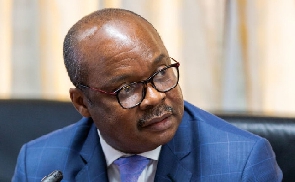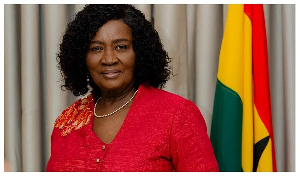The Monetary Policy Committee (MPC) of the Bank of Ghana (BoG) has increased the policy rate by 250 basis points to 27.0 percent.
This means the cost of borrowing will further go up.
The MPC announced this today, Monday, 28 November 2022, at a press conference.
In his address to the media, Governor of the Bank of Ghana, Dr. Ernest Addison, noted that the increase forms part of efforts to address current inflationary pressures.
The next MPC meeting is scheduled for January 24 - 27, 2023. The meeting will conclude on Monday, January 30, 2023, with the announcement of the policy decision.
Below is Dr Addison’s full address:
Good morning, Ladies and Gentlemen of the Media and welcome to the press briefing after the 109th Monetary Policy Committee (MPC) meetings which took place last week. The Committee deliberated on recent macroeconomic developments and assessed risks to the inflation and growth outlook. A summary of the assessment and key considerations that informed the Committee’s decision on the stance of monetary policy is provided below:
Global growth slackened in the third quarter of 2022 and is projected to weaken further amid tight financing conditions, rising cost of living and a squeeze on real incomes, alongside recession fears in advanced economies. Furthermore, Purchasing Managers Index releases for manufacturing and services activity point to weakened momentum in the last quarter of the year. The current phase of the business cycle, coupled with elevated macroeconomic, geopolitical and policy uncertainty concerns, has led to downward revisions of global growth projections. The International Monetary Fund has revised significantly downwards, global growth to 3.2 percent in 2022, nearly half of the 6.0 percent growth recorded in 2021.
Global headline inflation remains elevated and has broadened beyond food and energy prices, with several other factors adding to inflationary pressures. These include tighter labour market conditions, the pass-through effects of currency depreciations to inflation, and supply chain cost pressures. The International Monetary Fund projects global inflation to reach 8.8 percent by the end of 2022, before gradually declining to 4.1 percent in 2024. The projected ease in global inflation is conditioned on easing supply chain constraints, slowing global economic growth, declining global food prices, and lower crude oil prices.
Global financing conditions have tightened further, reflecting in large part the aggressive policy rate increases across several Advanced Economies to reanchor the persistent rise in inflation. The US dollar has strengthened, and longerterm bond yields have risen sharply because of sustained policy tightening in response to high inflation concerns. This has triggered currency pressures and volatility in equity markets across Emerging Markets and Developing Economies. Meanwhile, stock prices remained subdued amid rising interest rates and growing uncertainty about near-term global growth prospects. In a similar policy direction, central banks in several Emerging Market and Developing Economies have tightened monetary policy in response to rising inflation and currency pressures.
On the domestic front, inflation has remained elevated, with strong underlying inflationary pressures. Price developments suggest that the upturn of headline inflation in October 2022 was driven largely by food price pressures and to some extent additional pressures from the currency depreciation. Since the last MPC meeting, headline inflation has increased further to 40.4 percent in October 2022, from 37.5 percent in September. Food inflation increased by 4.9 percentage points to 43.7 percent in October 2022 from 38.8 percent in September, while non-food inflation increased by 1.3 percentage points to 37.8 percent from 36.5 percent.
Underlying inflationary pressures have also heightened further. The Bank’s measure of core inflation, defined to exclude energy and utility prices, increased from 36.2 percent in September 2022 to 39.7 percent in October 2022, an indication of broad-based inflationary pressures. At the same time, consumer, business, and financial sector inflation expectations went up.
Domestic economic activity have moderated somewhat. High frequency indicators monitored by the Bank signalled some moderation in economic activity in the third quarter, relative to the first two quarters of the year. The Bank’s Composite Index of Economic Activity (CIEA) contracted by 1.2 percent in September 2022, compared with 11.1 percent growth, a year earlier. The main indicators that dragged down the Index were domestic VAT, ports activity, and cement sales.
The Bank’s survey of Business and Consumer confidence conducted in October 2022 continue to point to softening economic sentiments. Consumer confidence dipped on account of rising inflation and uncertainty about future economic conditions. Business sentiments also deteriorated on concerns about rising operational costs, sharp currency depreciation, and weak consumer demand. These survey findings were aligned with the decline in Ghana’s Purchasing Managers’ Index (PMI), which eased further to 44.0 in October 2022 from 45.6, a month earlier.
The pace of expansion in monetary aggregates accelerated in October 2022, on the back of increased Net Domestic Assets of the depository corporation sector, while Net Foreign Assets declined sharply. Broad money supply, including foreign currency deposits (M2+) grew by 45.2 percent year-on-year in October 2022, compared with 14.5 percent in the same month of 2021. Reserve Money recorded an annual growth of 62.7 percent in October 2022, compared with 25.9 percent, over the same month a year earlier.
The latest credit conditions survey conducted in October 2022 pointed to expected continued tightening of credit stance to corporates and households by the commercial banks over the next six months. This is expected to reflect in a steady increase in average lending rates and marginal decline in credit demand by enterprises and households.
.New advances over the first ten months of 2022 amounted to GH¢45.3 billion, reflecting a year-to-date growth of 59.1 percent, compared with GH¢28.5 billion for same period in 2021. As a result, private sector credit grew by 57.3 percent in October 2022, relative to 10.1 percent in the corresponding period in 2021. The observed increase in new advances and private sector credit partly reflected 3 banks’ portfolio rebalancing behaviour and revaluation effects from foreign currency denominated credit. In real terms, private sector credit increased by 12.0 percent, compared with a 0.8 percent contraction over the same comparative period.
The banking sector recorded strong asset growth and improved profitability over the review period, but there are strong signs of emerging spillover effects from the recent macroeconomic challenges. Total assets of the banking industry amounted to GH¢249.9 billion (an annual growth of 43.7 percent) at the end of October 2022. Underpinning the growth in assets was sustained growth in deposits and borrowings, as well as the revaluation effect of the foreign currency component of key balance sheet indicators. Total deposits reached GH¢172.1 billion, representing an annual growth of 46.5 percent, compared with 17.2 percent during the same period in 2021. Borrowings also increased by 47.6 percent to GH¢30.4 billion from GH¢20.6 billion in October 2021. Total investments increased by 1.9 percent to GH¢85.0 billion in October 2022, compared with a growth of 25.5 percent during the same period last year. Gross advances, on the other hand, increased sharply by 57.5 percent to GH¢81.2 billion, relative to GH¢51.6 billion in October 2021.
Financial Soundness Indicators remain broadly positive. The industry’s Capital Adequacy Ratio (CAR) was 14.2 percent as at October 2022, above the prudential minimum of 13.0 percent, but shows a sharp decline from 19.8 percent recorded a year earlier. The reduction in the CAR levels broadly reflects the impact of ongoing macroeconomic developments, including the currency depreciation and the mark-to-market investment losses by some banks, as well as the continued growth in actual credit on the risk-weighted assets of banks. However, the NonPerforming Loans (NPL) ratio improved from 16.4 percent in October 2021 to 14.0 percent in October 2022, on account of the higher growth in credit relative to the increase in the NPL stock.
The banking sector remained profitable with profit-after-tax for the first ten months of 2022 at GH¢4.4 billion, representing an increase of 17.2 percent, compared with 10.0 percent growth during the same period last year. Net interest income grew by 22.7 percent to GH¢12.8 billion, higher than the 15.2 percent growth. Net fees and commissions also grew by 25.4 percent to GH¢2.9 billion, compared with 22.9 percent growth over the same comparative period. Operating income accordingly rose by 27.0 percent, higher than the corresponding growth of 14.3 percent in 2021. The industry’s operating expenses increased by 28.1 percent in October 2022, compared with 11.0 percent for same period in 2021, on the back of the current challenging operating environment. Loan loss provisions also went up significantly, reflecting the pickup in credit growth and elevated credit risks.
Interest rates on the money markets trended upwards across the spectrum of the yield curve, in line with the tightening of monetary policy stance. At the short-end of the market, the 91-day and 182-day Treasury bill rates increased to 31.53 percent and 32.61 percent respectively, in October 2022, from 12.46 percent and 13.16 percent respectively, in the same period of 2021. Similarly, the rate on the 364-day bill increased to 32.32 percent from 16.24 percent over the review period. On the secondary market, rates on all bonds, from 2-year through to 20-years, almost doubled over the one-year review period.
The interbank weighted average rate increased to 23.98 percent in October 2022 from 12.66 percent in October 2021, consistent with the increases in the policy rate and the incremental hikes in the Cash Reserve Ratio from 12 percent in August 2022 to 14 percent in October. In tandem, the average lending rates of banks rose to 31.40 percent in October 2022 from 20.34 percent in the same period of 2021.
Provisional data on fiscal operations for January to September 2022 resulted in an overall budget deficit of GH¢41.7 billion (7.0 percent of GDP), against a programmed deficit target of GH¢36.7 billion (6.2 percent of GDP). The corresponding primary balance was a deficit of 1.6 percent of GDP, against a deficit target of 1.0 percent of GDP. The higher-than-projected deficit was on account of revenue shortfalls alongside expenditure overruns. Total Revenue and Grants amounted to GH¢65.4 billion (11.0 percent of GDP), compared with a target of GH¢67.3 billion (11.4 percent of GDP), representing a shortfall of 2.8 percent compared to target and year-on-year growth of 33.2 percent. Total Expenditure (including arrears clearance and discrepancy) for the period amounted to GH¢109.4 billion (18.5 percent of GDP), above the target of GH¢103.99 billion (17.6 percent of GDP) by 5.2 percent. The resulting overall fiscal deficit of GH¢41.7 billion was financed mainly from domestic sources.
The public debt stock (excluding overdraft, SOEs and SPVs) was GH¢467.4 billion (75.9 percent of GDP) as at end September 2022, compared with GH¢351.8 billion (76.6 percent of GDP) at the end of December 2021. Of the total debt stock, domestic debt was GH¢195.7 billion (31.8 percent of GDP), while the external debt was GH¢271.7 billion (39.9 percent of GDP).
. External sector developments show mixed trends in the prices of Ghana’s main export commodities. Brent crude prices eased from the highs of over US$100 per barrel to US$93.6 per barrel in October 2022, recording a year-to-date growth of 25.1 percent. The recent decline in crude prices mainly reflects global recession fears amid weakened growth momentum in China. Gold prices trended downwards to US$1,666.7 per fine ounce in October 2022, representing a drop of 6.9 percent, on the back of a strong US dollar and rising interest rates. Cocoa prices settled at an average price of US$2,337.71 per tonne in October, down by 5.8 percent year-to-date, owing to expectations of a large crop and mixed grinding data.
Provisional data on the balance of payments show that the current account deficit deteriorated from 2.4 percent of GDP (US$1,860.3 million) in September 2021 to 2.8 percent of GDP (US$1,831.6 million) in September 2022. The higher deficit was on account of higher payment outflows in the services and income accounts, which offset the significant improvement in the trade surplus recorded over the period. The capital and financial account recorded significant outflows amounting to US$1,486.0 million during the review period, compared with inflows of US$3,491.0 million a year earlier. The outflows were explained by portfolio reversals, reduced FDI inflows, lower private capital inflows, and higher build-up of deposit taking corporations foreign assets. The current account deficit, together with outflows in the capital and financial accounts, resulted in a balance of payments deficit of US$3,410.0 million at the end of September 2022, compared 5 with a balance of payments surplus of US$510.0 million in December 2021, leading to a significant drawdown in international reserves
At the end of October 2022, the stock of Gross International Reserves position had declined to US$6.7 billion equivalent to 2.9 months of import cover compared with the reserve level of US$9.7 billion (4.3 months of imports) at the end of December 2021. Net International Reserves, which excludes encumbered assets and petroleum funds, was estimated at US$2.8 billion as at October 2022.
The significant decline in reserve buffers arising partly from loss of market access, significant portfolio reversals, rising petroleum product importation bill, market reaction to sovereign downgrades by rating agencies on fiscal concerns, alongside increased foreign exchange demand exerted intense pressures on the local currency. In the year to November 24, 2022, the Ghana Cedi cumulatively depreciated by 54.2 percent, 48.9 percent, and 49.9 percent against the US dollar, the Pound, and Euro, respectively. In comparison with the same period of last year, the Ghana Cedi was much stronger, depreciating by 2.6 percent and 0.2 percent against the US dollar and the Pound, respectively, and appreciated by 6.6 percent against Euro.
Summary and Outlook
Two years since the Covid-19 pandemic and a war in-between, the global economy continues to face severe headwinds coupled with heightened uncertainties. Global growth has slowed, with recession concerns dominating markets in the near term. Global inflation remains high, driven largely by food and energy prices. Central Banks’ resolve to dampen the persistent and broad-based inflation pressures globally has led to aggressive policy tightening in Advanced Economies. The US Federal Reserve has frontloaded its policy tightening cycle, resulting in tight global financing conditions and a stronger US dollar against major international currencies. These developments have spilled over into currency pressures and imported inflation, complicated access to external capital markets, and resulted in acute capital outflows, especially in emerging markets and frontier economies. Risks to the global outlook are firmly on the downside reflecting possibility of policy mistakes amid deteriorating growth and elevated inflation, tighter financing conditions, and stronger US dollar. These external shocks have had severe consequences on the Ghanaian economy, reflected in high and rising inflation from exchange rate pass-through effects, and complicated the policy environment.
The foreign exchange market witnessed increased volatility, with intense pressure on the local currency, especially in September and October. Factors such as tightening global financing conditions, the sovereign downgrades, the de facto closure to the international capital market, portfolio reversals, and increased demand for foreign exchange amid supply constraints, contributed to the significant weakening of the Ghana cedi. More recently, the sharp depreciation episode has been driven by speculation of a possible debt restructuring which led to portfolio rebalancing in favour of foreign currency holdings as against Ghana cedi denominated assets. Looking ahead, the next few readings of inflation will shed light on the extent of pass-through of the accelerated depreciation of the Ghana cedi in October on inflation dynamics.
Notwithstanding the significant improvement in the trade surplus, largely driven by higher export receipts from increased gold production and higher crude oil prices, relative to imports, the current account deficit widened, reflecting increased cost of imported petroleum products arising from higher crude oil prices. This underscores the fact that, on average, higher crude oil prices have relatively modest gains on the trade account. The balance of payments swung into a deficit in the first nine months, from a surplus last year due to continuing large current account deficit and, importantly, significant outflows in the capital and financial account. These developments culminated in significant loss of reserves, resulting in further currency pressures. With no access to the international capital market for financing, reserves build-up has been constrained. Risks to the external sector outlook are therefore on the upside and measures are being taken to gradually rebuild reserves in more sustainable ways to preserve stability, going forward.
The implementation of the 2022 Budget has come under severe stress. Revenue shortfalls, expenditure rigidities, lack of access to the international capital market to fund the budget, uncovered auctions and non-resident portfolio reversals have all acted to create a huge financing gap. With access to external capital market closed and domestic market under performing, there has been severe pressure on the Bank of Ghana’s overdraft facility available to Government for short term cashflow management, without which the Government would have had difficulty in meeting its obligations. The 2023 Budget Statement has committed to reset fiscal policy and firmly place it on the course of fiscal consolidation. New revenue measures and expenditure rationalization measures have been announced. To guarantee debt sustainability over the medium term, a debt exchange operation is proposed to be undertaken to support the consolidation agenda. The broad expectation is for steadfast implementation of these measures to foster confidence, improve the debt-metrics and complement the current monetary policy stance at tackling current inflationary pressures.
Although domestic growth conditions have been strong in the first half of the year, latest high frequency indicators point to some moderation. The Bank’s CIEA contracted year-on-year in the third quarter, on the back of weakened consumption, trade, and construction activities. These trends signal that growth may remain below potential levels on account of rising cost of living amid significant uncertainty in the outlook. Both business and consumer sentiments continue to soften and remain at low levels. Despite these trends, private sector credit growth, in real terms, remains relatively strong and provides scope for the real sector to continue on the path of sustaining a positive outlook for economic activity.
On the transmission of monetary policy changes to inflation, the Committee was of the view that there is evidence that the policy rate increases in the past few months have helped dampen the pace of monthly price increases. Between May and August 2022, the monthly inflation number eased from a peak of 5.1 percent to 1.9 percent. However, this was reversed in September and October on account of additional shocks from upward adjustment in ex-pump petroleum prices, utility tariff adjustments, and transportation fare increases. In the event, inflation jumped in October 2022 to 40.4 percent and has dragged along with it, core inflation, which is almost at par with headline inflation and indicating significant underlying inflation pressures and upside risks to the inflation outlook.
The inflation forecast shows that in the outlook, inflation will likely peak in the first quarter of 2023 and settle at around 25 percent by the end of 2023. This forecast is conditioned on the continued maintenance of tight monetary policy stance and the deployment of tools to contain excess liquidity in the economy. There are however some risks to this forecast that would have to be monitored, including additional pressures from the proposed VAT increase, and exchange rate pressures. Continued vigilance to the evolution of these potential price pressures in the outlook will be key.
The Committee is of the view that significant upside risks to the inflation outlook remain. To continue to anchor inflation expectations, the Committee therefore decided to increase the policy rate by 250 basis points to 27.0 percent.
General News of Tuesday, 29 November 2022
Source: classfmonline.com

















